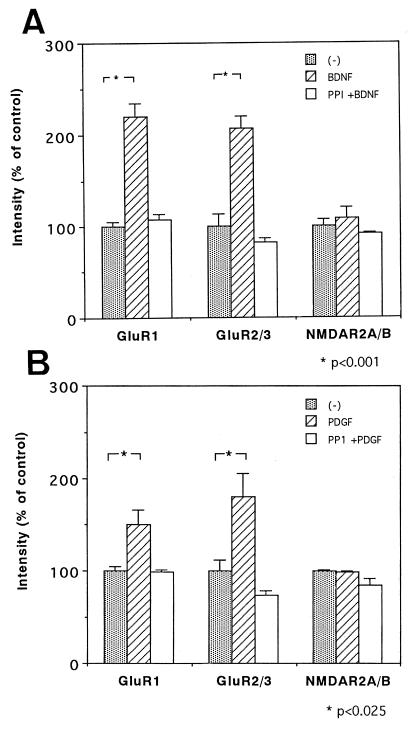Figure 2.
Effects of a Src-family-specific inhibitor on the growth factor-mediated increases in AMPA receptors. Rat neocortical cultures were prepared as shown in Fig. 1 and were treated with BDNF (A) or PDGF (B) in the presence or absence of a Src-family PTK inhibitor, PP1 (n = 3–4 for each condition). The effects of these factors and PP1 on the level of GluR1, GluR2/3, and NMDAR2A/B proteins were determined by immunoblotting. For statistical analyses, independent blots were made, and each immunoreactivity on the blots was measured by densitometry. The average control receptor level was set as 100% for each immunoblot. Statistical analysis was performed by using one-way ANOVA followed by the Bonferroni test. Protein levels of NMDAR2A/B and α-tubulin (data not shown) were not significantly altered by the treatments (F [2,6] = 1.1 in A and F [2,9] = 3.7 in B for NMDAR2A/B, and F [2,6] = 1.2 in A and F [2,9] = 0.7 in B for α-tubulin). The action of the inhibitor was controlled by monitoring the basal tyrosine phosphorylation level with an antiphosphotyrosine antibody (PY20); tyrosine phosphorylation of p60 was reduced to 58.1 ± 0.4% (P <0.001; n = 3). Protein recovery was not affected significantly by the growth factors or by PP1; control for BDNF; 0.550 ± 0.017 mg/dish, BDNF; 0.578 ± 0.022 mg/dish and PP1 plus BDNF; 0.480 ± 0.031 mg/dish (F [2,6] = 4.43), and control for PDGF; 0.616 ± 0.022 mg/dish, PDGF; 0.600 ± 0.025 mg/dish; PP1 plus PDGF; 0.578 ± 0.006 mg/dish (F [2,6] = 0.43).

